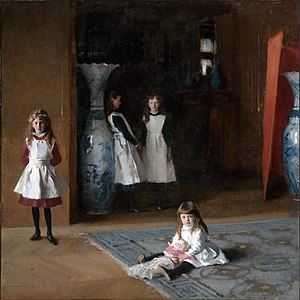The Daughters of Edward Darley Boit
| The Daughters of Edward Darley Boit | |
|---|---|
 |
|
| Artist | John Singer Sargent |
| Year | 1882 |
| Medium | Oil on canvas |
| Dimensions | 222.5 cm × 222.5 cm (87.6 in × 87.6 in) |
| Location | Museum of Fine Arts, Boston |
The Daughters of Edward Darley Boit (originally titled Portraits d'enfants) is a painting by John Singer Sargent. The painting depicts four young girls, the daughters of Edward Darley Boit, in their family's Paris apartment. It was painted in 1882 and is now exhibited in the new Art of the Americas Wing of the Museum of Fine Arts in Boston. The painting hangs between the two tall blue-and-white Japanese vases depicted in the work; they were donated by the heirs of the Boit family.
It has been described as "Arguably the most psychologically compelling painting of Sargent's career". Though the painting's unusual composition was noted from its earliest viewings, initially its subject was interpreted simply as that of girls at play, but it has subsequently been viewed in more abstract terms, reflecting Freudian analysis and a greater interest in the ambiguities of adolescence.
Edward Boit was the son-in-law of John Perkins Cushing and a friend of Sargent's. Boit was an "American cosmopolite" and a minor painter. His wife and the mother of his five children was Mary Louisa Cushing, known as "Isa". Their four daughters were Florence, Jane, Mary Louisa and Julia.
It is not certain whether The Daughters of Edward Darley Boit was commissioned by Boit or painted at Sargent's suggestion. Set in what is thought to be the foyer of Boit's Paris apartment, its dark interior space is reminiscent of those Sargent had recently painted in Venice. The composition was unusual for a group portrait, both for the varying degrees of prominence given to the figures—conventional group portraiture called for an arrangement in which the subjects were portrayed as equally important—and for the square shape of the canvas.
The dimensions may owe something to the influence of Diego Velázquez's Las Meninas, which Sargent had copied, and which presages the geometric format and broad, deep spaces of Sargent's painting. When the painting was first exhibited, contemporary critics, including Henry James, wrote of Sargent's debt to Velázquez.
Art historian Barbara Gallati notes that the English translation of Las Meninas, "Maids-in-Waiting", is an apt description for the activity of the Boit children.Carolus-Duran, Sargent's teacher, had encouraged his students to study the work of Velásquez. The relationship between the works is considered so significant that the Museum of Fine Arts (Boston) loaned The Daughters to the Museo del Prado in 2010, so that the paintings could be exhibited together for the first time.
...
Wikipedia
